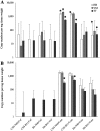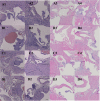Generality of Post-Antimicrobial Treatment Persistence of Borrelia burgdorferi Strains N40 and B31 in Genetically Susceptible and Resistant Mouse Strains
- PMID: 31308087
- PMCID: PMC6759297
- DOI: 10.1128/IAI.00442-19
Generality of Post-Antimicrobial Treatment Persistence of Borrelia burgdorferi Strains N40 and B31 in Genetically Susceptible and Resistant Mouse Strains
Abstract
A basic feature of infection caused by Borrelia burgdorferi, the etiological agent of Lyme borreliosis, is that persistent infection is the rule in its many hosts. The ability to persist and evade host immune clearance poses a challenge to effective antimicrobial treatment. A link between therapy failure and the presence of persister cells has started to emerge. There is growing experimental evidence that viable but noncultivable spirochetes persist following treatment with several different antimicrobial agents. The current study utilized the mouse model to evaluate if persistence occurs following antimicrobial treatment in disease-susceptible (C3H/HeJ [C3H]) and disease-resistant (C57BL/6 [B6]) mouse strains infected with B. burgdorferi strains N40 and B31 and to confirm the generality of this phenomenon, as well as to assess the persisters' clinical relevance. The status of infection was evaluated at 12 and 18 months after treatment. The results demonstrated that persistent spirochetes remain viable for up to 18 months following treatment, as well as being noncultivable. The phenomenon of persistence in disease-susceptible C3H mice is equally evident in disease-resistant B6 mice and not unique to any particular B. burgdorferi strain. The results also demonstrate that, following antimicrobial treatment, both strains of B. burgdorferi, N40 and B31, lose one or more plasmids. The study demonstrated that noncultivable spirochetes can persist in a host following antimicrobial treatment for a long time but did not demonstrate their clinical relevance in a mouse model of chronic infection. The clinical relevance of persistent spirochetes beyond 18 months following antimicrobial treatment requires further studies in other animal models.
Keywords: Borrelia burgdorferi; antimicrobial tolerance; mouse model; persistence.
Copyright © 2019 American Society for Microbiology.
Figures




Similar articles
-
Persistent Borrelia burgdorferi Sensu Lato Infection after Antibiotic Treatment: Systematic Overview and Appraisal of the Current Evidence from Experimental Animal Models.Clin Microbiol Rev. 2022 Dec 21;35(4):e0007422. doi: 10.1128/cmr.00074-22. Epub 2022 Oct 12. Clin Microbiol Rev. 2022. PMID: 36222707 Free PMC article. Review.
-
Resurgence of persisting non-cultivable Borrelia burgdorferi following antibiotic treatment in mice.PLoS One. 2014 Jan 23;9(1):e86907. doi: 10.1371/journal.pone.0086907. eCollection 2014. PLoS One. 2014. PMID: 24466286 Free PMC article.
-
Comparative molecular analyses of Borrelia burgdorferi sensu stricto strains B31 and N40D10/E9 and determination of their pathogenicity.BMC Microbiol. 2012 Jul 30;12:157. doi: 10.1186/1471-2180-12-157. BMC Microbiol. 2012. PMID: 22846633 Free PMC article.
-
Decorin binding proteins of Borrelia burgdorferi promote arthritis development and joint specific post-treatment DNA persistence in mice.PLoS One. 2015 Mar 27;10(3):e0121512. doi: 10.1371/journal.pone.0121512. eCollection 2015. PLoS One. 2015. PMID: 25816291 Free PMC article.
-
Lyme Borreliosis: Is there a preexisting (natural) variation in antimicrobial susceptibility among Borrelia burgdorferi strains?Bosn J Basic Med Sci. 2015 Jul 8;15(3):1-13. doi: 10.17305/bjbms.2015.594. Bosn J Basic Med Sci. 2015. PMID: 26295288 Free PMC article. Review.
Cited by
-
The Brilliance of Borrelia: Mechanisms of Host Immune Evasion by Lyme Disease-Causing Spirochetes.Pathogens. 2021 Mar 2;10(3):281. doi: 10.3390/pathogens10030281. Pathogens. 2021. PMID: 33801255 Free PMC article. Review.
-
Superior efficacy of combination antibiotic therapy versus monotherapy in a mouse model of Lyme disease.Front Microbiol. 2023 Nov 21;14:1293300. doi: 10.3389/fmicb.2023.1293300. eCollection 2023. Front Microbiol. 2023. PMID: 38075920 Free PMC article.
-
Lyme disease and the pursuit of a clinical cure.Front Med (Lausanne). 2023 May 24;10:1183344. doi: 10.3389/fmed.2023.1183344. eCollection 2023. Front Med (Lausanne). 2023. PMID: 37293310 Free PMC article. Review.
-
Persistent Borrelia burgdorferi Sensu Lato Infection after Antibiotic Treatment: Systematic Overview and Appraisal of the Current Evidence from Experimental Animal Models.Clin Microbiol Rev. 2022 Dec 21;35(4):e0007422. doi: 10.1128/cmr.00074-22. Epub 2022 Oct 12. Clin Microbiol Rev. 2022. PMID: 36222707 Free PMC article. Review.
-
A Practical Approach to the Diagnosis of Lyme Borreliosis: From Clinical Heterogeneity to Laboratory Methods.Front Med (Lausanne). 2020 Jul 23;7:265. doi: 10.3389/fmed.2020.00265. eCollection 2020. Front Med (Lausanne). 2020. PMID: 32793606 Free PMC article. Review.

